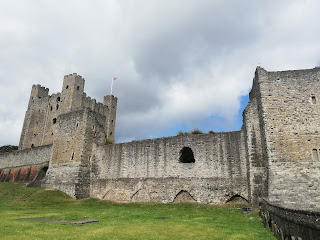14 km
Remember the days of old, consider the years that are past; ask your father and he will show you, ask your elders and they will tell you
- Deuteronomy 32: 1 - 12 (reading at morning prayer in Aylesford Priory)
In the morning I walked back into the centre of Rochester from my room in the townhouse by the river. I wanted to take another look around the cathedral. And it was a completely different cathedral from the one I saw at evensong the night before! This Rochester Cathedral thronged with schoolchildren and teenagers, visitors and tourists, casually lounging about on the steps and posing for pictures with Gaia, the art installation by Luke Jerram currently on display in the nave.
This Rochester Cathedral had some features I hadn't been able to access the previous evening, such as a rose garden in the cloister, a café in the crypt, and a gift shop for picking up a pilgrim badge for my backpack.
 |
| Chapel of St Ithamar |
The Cathedral was rebuilt following the Norman invasion as the Benedictine Priory of St Andrew, and again after it was damaged by fire in the 12th century. The Priory became Rochester Cathedral when King Henry VIII dissolved the monastery in 1542.
Across from the Cathedral stands the well-preserved stone keep of twelfth-century Rochester Castle, granted to the Archbishop of Canterbury by King Henry I in 1127 and of strategic importance for the defence of southeastern England.
I took another look at the High Street where I had taken my supper the night before and poked around a second-hand bookshop called Baggins; I couldn't buy any books, of course, but with a name like that, who could resist? Then I set the kilometre counter going outside the Cathedral and set off on my way, stopping to pick up my bag from my accommodation on the way out of town.
I returned to my route not on St. Bernard's Way, but following the North Downs Way - Rochester Detour. This would take me to Peters Bridge, the new bridge across the Medway River at Halling, to join up with the route that crosses the river there and continues on to Aylesford, allowing me to visit both Rochester and Aylesford on my way to Canterbury.
I passed underneath the motorway and rail bridges I had crossed the previous day and followed the footpath along the embankment of the Medway, marked as the Augustine Camino.
- Charles Dickens, The Pickwick Papers
When I arrived at three I had not had any lunch, so my first stop was the tearoom for an egg and cress sandwich and a scone with clotted cream and jam. Then I checked into my lovely room in the Tudor wing of the Priory. After a short rest I walked into the village of Aylesford and across the old bridge to the neighbourhood where we lived when I was small, around the time when my sister was born and before we emigrated to Canada. I knew that the house we lived in was no longer there, as one of the reasons why we left was that it was slated for destruction to build the new motorway. So I went in search of Teapot Lane to find the spot where it used to be. There is now a pedestrian overpass across the motorway at the exact spot where the house was, connecting Teapot Lane with Aylesford Railway Station on the other side. I was thus able to walk over the very spot associated with my earliest childhood memories, however drastically it may have changed!
 |
| The old town of Aylesford |
 |
| The footbridge where 103 Teapot Lane used to be |
 |
| The last house left standing at the end of Teapot Lane |
 |
| No. 99 - would have been two houses down from us |
 |
| 103 Teapot Lane, pre-1970 |
 |
| Me in Aylesford (Maidstone) - from an old scrapbook album |
 |
| Where we used to live - now the M20 |
I returned to the Priory just in time for the evening prayer service and dinner in the Pilgrims' Hall, taken in the company of a number of church groups assembled for weekend retreats. I then retired to my room to plan and book my accommodations for the final days of my walk to Canterbury and Dover!
 |
| The open-air shrine at Aylesford Priory |
 |
| In the Rosary Garden |
 |
| Accommodations at Aylesford Priory |
 |
| Pilgrims' Hall dining room |
 |
| Guest lounge |
 |
| Corridor |














No comments:
Post a Comment